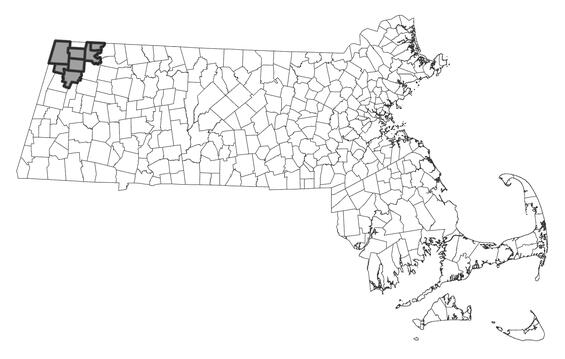- Scientific name: Solidago macrophylla Banks
- Species of Greatest Conservation Need (MA State Wildlife Action Plan)
Special Concern (MA Endangered Species Act)
Description
Large-leaved goldenrod is a 30-80 cm (1-2.5 ft) tall, perennial herbaceous plant in the Asteraceae or daisy family. The lower leaf blades are large, 3-15 cm (1.2-6 in) long, sharply toothed, oval shaped, and taper abruptly to the leafstalk. Basal leaves are likewise toothed but are also tufted, situated on long stalks and usually persistent long after their appearance in late spring. Flowers are golden-yellow and form a narrow, club-shaped elongate inflorescence. Each flower head is large compared to other goldenrods, comprised of many small florets, and rests on a very short stalk. The dry fruits (achenes) are smooth and about 4-5 mm long (0.2 in). Flowering season is late July-September.
Cut-leaved goldenrod (Solidago arguta) resembles large-leaved goldenrod, but the former has a more arching or elm-like inflorescence. It inhabits rocky woodlands generally at lower elevations than large-leaved goldenrod.
Life cycle and behavior
This is a perennial species.

Population status
Large-leaved goldenrod is listed under the Massachusetts Endangered Species Act as Threatened. All listed species are protected from killing, collecting, possessing, or sale and from activities that would destroy habitat and thus directly or indirectly cause mortality or disrupt critical behaviors. It is currently known from Berkshire and Franklin Counties and is historically known from Hampshire County. In Massachusetts, large-leaved goldenrod is at the southern limit of its range which, in part, accounts for its rarity. The lack of high elevations, coupled with our relatively high summer temperatures, may also be contributing factors to its rarity.
Distribution and abundance
Large-leaved goldenrod is a northern species found from Newfoundland to Ontario, south to the Green Mountains, Adirondacks, northern Berkshire Plateau, Mt. Greylock, and one historical record from Massachusetts near the Notch in the Holyoke Range. NatureServe ranks large-leaved goldenrod as G5, Globally Secure. It is also considered imperiled on Prince Edward Island.

Distribution in Massachusetts. 1999-2024. Based on records in the Natural Heritage Database.
Habitat
This species is found at high elevations in cool woods within filtered light or full sun along roadsides and trails, in thickets, clearings and open summits, and in damp woods with an open understory. Some sites have short, stunted trees. The plants largely occur in canopy openings on shallow, stony soil in high elevation spruce-fir forests or a spruce–fir-northern hardwood forests. The overhead or nearby canopy usually includes balsam fir (Abies balsamea), red spruce (Picea rubens), yellow birch (Betula alleghaniensis), heart-leaved birch (B. cordifolia), black cherry (Prunus serotina), American beech (Fagus grandifolia), and red and sugar maples (Acer rubrum and A. saccharum), with American mountain-ash (Sorbus americana), striped maple (A. pensylvanica), mountain maple (A. spicatum), Bartram's shadbush (Amelanchier bartramiana), hobblebush (Viburnum lantanoides) and blackberries (Rubus spp.). The associated herbaceous layer can include hay-scented fern (Dennstaedtia punctilobula), mountain woodfern (Dryopteris campyloptera), intermediate woodfern (D. intermedia), Christmas fern (Polystichum acrostichoides), Lycopodium spp., wood sorrel (Oxalis acetosella), Canada mayflower (Maianthemum canadense), whorled wood-aster (Oclemena acuminata), yellow clintonia (Clintonia borealis) and various graminoids such as common hairgrass (Deschampsia flexuosa), woodland millet (Millium effusum), and stalked sedge (Carex debilis).
Healthy habitats are vital for supporting native wildlife and plants. Explore habitats and learn about conservation and restoration in Massachusetts.
Threats
Several of the known populations are along trails or access roads to summits and ridges, others are on summits. Widening of trails and erosion and soil disturbance are potential threats, as is mowing trail edges during the growing season. Clearing followed by dense regrowth are threats on summits and along road accesses for wind towers and other summit development. Impacts of opening canopies such as drying of the soil, invasion by other species and too much sun exposure are threats.
Conservation
Any trail maintenance should be done with knowledge of the plant locations. Habitat conditions can be kept suitable for populations by maintaining open areas of filtered sunlight below a sparse canopy. Rare plant locations that receive heavy recreational use should be carefully monitored for plant damage or soil disturbance; trails can sometimes be re-routed to protect the population. All active management of rare plant populations (including invasive species removal) is subject to review under the Massachusetts Endangered Species Act and should be planned in close consultation with the MassWildlife’s Natural Heritage & Endangered Species Program.
Contact
| Date published: | May 8, 2025 |
|---|